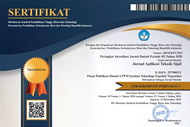Analisa Tidak Linier Mekanisme Keruntuhan Jembatan Busur Rangka Baja (A-Half Through Arch)
Abstract
The collapses of steel truss bridges can be caused by some factors such as vehicle overloads, material deterioration (corrosion, fatigue), and unexpected tsunami and/or earthquake loads. However, in this paper, the study is limited only to the failure of a-half through arch bridge due to earthquake loads. The bridge has a 100 m long span and is designed using the response spectrum of Surabaya city, East Java, Indonesia. Static nonlinear push-over analysis is used to investigate the performance and the collapse mechanism of the bridge. The bridge was designed based on SNI 1725-2016 and SNI 2833-2016. From the analysis, the failure of the structural elements occurred in the arch members located somewhere near the end portal. The performance level of the bridge determined using the Capacity Spectrum Method [1] is at the Immediate Occupancy (IO) level.
"--------------------------------------------------------------------------------"
Keruntuhan jembatan bisa disebabkan beberapa faktor seperti beban berlebih, fatik, korosi, gempa bumi dan/atau tsunami. Namun, dalam artikel ini, penelitian dibatasi hanya pada kegagalan jembatan busur dengan tipe a-half through arch bridge yang diakibatkan oleh beban gempa. Jembatan yang ditinjau memiliki bentang 100 m dan didesain sesuai dengan zona gempa kota Surabaya, Jawa Timur – Indonesia. Jembatan didesain dengan menggunakan SNI 1725-2016 dan SNI 2833-2016. Analisa beban dorong tidak linear digunakan untuk mengetahui kinerja dan mekanisme keruntuhan struktur jembatan. Berdasarkan hasil studi menunjukkan bahwa kegagalan elemen struktur jembatan terjadi pada elemen busur dekat portal akhir. Level kinerja struktur jembatan ditentukan dengan Metode Kapasitas Spektrum [1] dan termasuk dalam level Immediate Occupancy (IO).
Keywords
Full Text:
PDFReferences
ATC-40, Seismic Evaluation and Retrofit of Concrete Building. Redwood City, California, U.S.A.: Applied Technology Council, 1996.
PU, “Investigasi Jembatan Rangka Baja,” Jakarta, 2009.
The Jakarta Post, “Central Sulawesi Quake: What We Know so Far,” Jakarta, 28-Sep-2018.
Tempo, “Tangani Jembatan Widang Ambruk, Menteri PU Kirim Kerangka Baja,” Tuban, 17-Apr-2018.
Abolhassan Astaneh-Asl, “Progressive Collapse of Steel Truss Bridges, The Case of I-35W Collapse,” in Seventh International Conference on Steel Bridge, 2008.
Kazuhiro Miyachi, S. Nakamura, and A. Manda, “Progressive Collapse Analysis of Steel Truss Bridges and Evaluation of Ductility,” J. Constr. Steel Res., pp. 192–200, 2012.
E. Yamaguchi, R. Okamoto, and K. Yamada, “Post-Member-Failure Analysis Method of Steel Truss Bridge,” Procedia Eng., pp. 656–661, 2011.
SNI:1725, Pembebanan untuk Jembatan. Jakarta: Standar Nasional Indonesia, 2016.
SNI:2833, Perencanaan Jembatan terhadap Beban Gempa. Jakarta: Standar Nasional Indonesia, 2016.
PEER-Center, Guidelines for Nonlinear Analysis of Bridge Strcutures in California. University of California Berkeley: 9. Pacific Earthquake Engineering Research Center, 2008.
DOI: http://dx.doi.org/10.12962%2Fj2579-891X.v17i1.4764
Refbacks
- There are currently no refbacks.

Jurnal Aplikasi Teknik Sipil by Pusat Publikasi Ilmiah LPPM Institut Teknologi Sepuluh Nopember is licensed under a Creative Commons Attribution-ShareAlike 4.0 International License
Based on work at https://iptek.its.ac.id/index.php/jats




